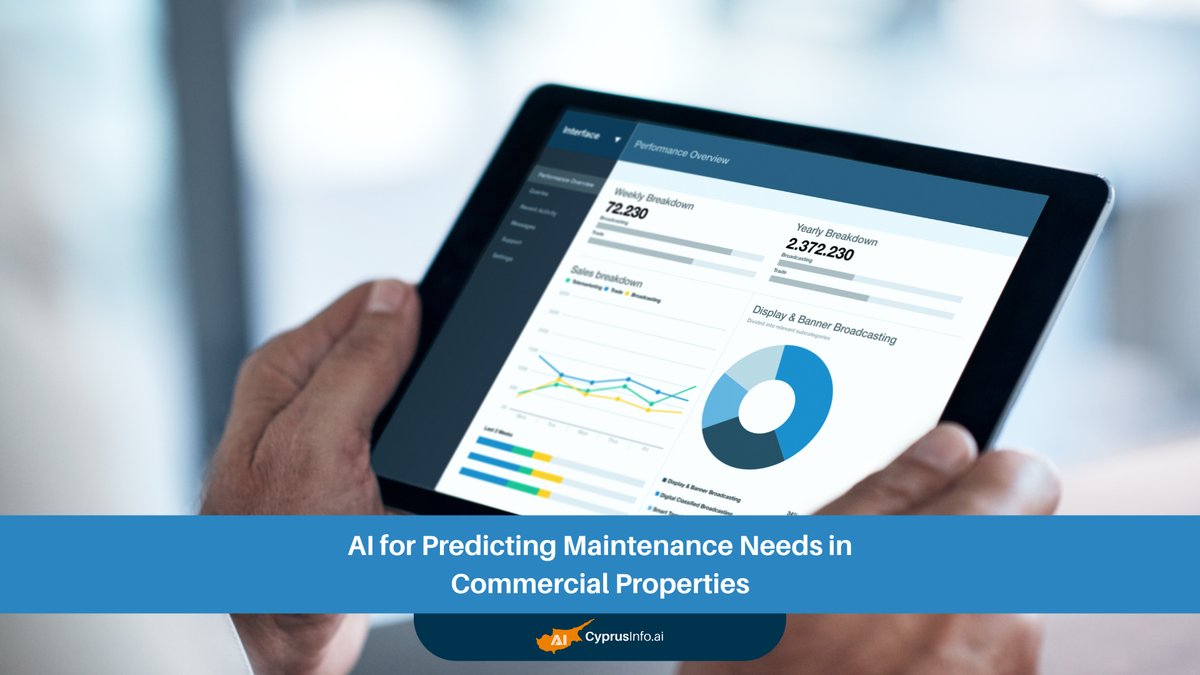In the rapidly evolving landscape of real estate and facility management, the ability to anticipate and address issues before they escalate is paramount. Traditional maintenance approaches, often reactive or time-based, frequently lead to unexpected breakdowns, costly repairs, and significant operational disruptions. However, a new paradigm is emerging, driven by artificial intelligence. AI predictive maintenance for commercial buildings is transforming how property managers approach asset upkeep, promising unprecedented levels of efficiency, cost savings, and operational continuity. This expert-level guide delves into the transformative power of AI in predicting maintenance needs, exploring its mechanisms, benefits, challenges, and future implications for commercial properties.
Commercial properties, ranging from towering office complexes and bustling retail centers to sprawling industrial facilities, represent substantial investments. Their smooth operation is critical to business continuity, tenant satisfaction, and long-term asset value. The integration of advanced analytics and machine learning techniques provides a proactive edge, shifting from reactive repairs to intelligent, data-driven interventions. This is where AI predictive maintenance for commercial buildings shines brightest.
The Shift from Reactive to Predictive Maintenance in Commercial Properties
For decades, maintenance strategies have largely fallen into two categories: reactive and preventive. Reactive maintenance addresses issues only after a failure occurs, leading to downtime, emergency costs, and potential safety hazards. Preventive maintenance, while better, relies on fixed schedules, often resulting in unnecessary maintenance or missing impending failures between scheduled checks.
The advent of AI introduces a third, far more sophisticated approach: predictive maintenance. By leveraging vast amounts of data from sensors, building management systems (BMS), and external sources, AI algorithms can identify patterns and anomalies that signal potential equipment failure. This allows property managers to schedule maintenance precisely when it's needed, optimizing resources and minimizing disruption. The move towards AI predictive maintenance for commercial buildings is not merely an upgrade; it's a fundamental rethinking of maintenance philosophy.
Why Predictive Maintenance with AI is Crucial
Minimizes Downtime: Predict failures before they happen, ensuring continuous operation.
Reduces Costs: Avoid expensive emergency repairs and extend asset lifespan.
Optimizes Resources: Schedule maintenance only when necessary, improving labor and spare parts management.
Enhances Safety: Proactive identification of potential hazards in critical systems.
Increases Asset Value: Well-maintained properties retain and appreciate value more effectively.
How AI Predictive Maintenance for Commercial Buildings Works
At its core, AI predictive maintenance for commercial buildings involves collecting, processing, and analyzing data to forecast equipment breakdowns. This process is multifaceted and relies on several technological pillars:
Data Collection: The Foundation of Intelligent Maintenance
The first step involves gathering data from various sources within a commercial property. This includes:
IoT Sensors: Temperature, humidity, vibration, pressure, current, and acoustic sensors provide real-time operational data from HVAC systems, elevators, lighting, plumbing, and other critical infrastructure.
Building Management Systems (BMS): Centralized systems that control and monitor building functions often contain historical performance data.
Historical Maintenance Records: Past repair logs, component lifespans, and technician notes offer valuable context for AI models.
External Data: Weather forecasts, energy prices, and even local event schedules can influence building operations and maintenance needs.
Quote: "Data is the new oil, and AI is the refinery that turns it into actionable insights, especially in complex environments like commercial property management." - Andrew Ng, AI Pioneer.
Advanced Analytics and Machine Learning Algorithms
Once data is collected, it feeds into powerful AI and machine learning algorithms. These algorithms perform several crucial functions:
Pattern Recognition: AI identifies normal operating parameters and deviations that might indicate impending failure. For instance, a slight increase in motor vibration or an unusual energy consumption pattern could signal a problem.
Anomaly Detection: Machine learning models are trained to spot outliers in data that human eyes might miss, pinpointing unusual behavior in equipment.
Predictive Modeling: Utilizing techniques like regression analysis, time-series forecasting, and neural networks, AI predicts the remaining useful life (RUL) of components or the probability of failure within a specific timeframe.
Root Cause Analysis: Some advanced AI systems can even suggest the most probable root cause of a detected anomaly, guiding maintenance teams directly to the problem.
This intelligent analysis underpins effective AI predictive maintenance for commercial buildings, transforming raw data into foresight.
Integration with Facility Management Systems
The insights generated by AI must be integrated seamlessly into existing facility management workflows. This often involves:
Automated Work Order Generation: AI systems can automatically create maintenance tickets when a potential issue is detected, assigning it to the appropriate technician.
Inventory Management: Predicting future maintenance needs allows for optimized spare parts inventory, reducing holding costs and ensuring availability.
Scheduling Optimization: Maintenance tasks can be scheduled to minimize disruption to tenants and operations, considering factors like peak usage times and technician availability.
Benefits of Implementing AI Predictive Maintenance in Commercial Properties
The adoption of AI predictive maintenance for commercial buildings yields a multitude of advantages that impact both the bottom line and operational excellence.
Significant Cost Reductions
One of the most compelling benefits is cost savings. By preventing catastrophic failures, commercial properties avoid:
Emergency Repair Costs: Expedited services and overtime pay for urgent repairs are significantly reduced.
Downtime Losses: Lost revenue or productivity due to equipment outages, especially in critical systems like HVAC or refrigeration, are minimized.
Unnecessary Maintenance: Performing maintenance only when needed extends the life of components and reduces the cost of premature replacements.
A study by Deloitte suggested that predictive maintenance can reduce maintenance costs by 5-10%, increase asset availability by 10-20%, and reduce safety risks by 10-20%. This directly contributes to improved operational efficiency AI brings to property management.
Enhanced Operational Efficiency and Reliability
AI predictive maintenance for commercial buildings ensures that critical systems operate at peak performance, enhancing overall operational efficiency. This leads to:
Increased Asset Uptime: Equipment operates longer without unexpected interruptions.
Optimized Energy Consumption: Identifying and addressing inefficiencies in systems like HVAC can lead to substantial energy savings, aligning with goals for energy efficiency AI. (Internal link: How AI Can Optimize Building Energy Efficiency in Cyprus)
Better Resource Allocation: Maintenance teams can focus on strategic tasks rather than constant firefighting.
Traditional vs. AI Predictive Maintenance
Feature | Traditional Maintenance | AI Predictive Maintenance |
|---|---|---|
Approach | Reactive (breakdown) or Time-based (scheduled) | Data-driven (condition-based) |
Cost Impact | High emergency costs, potential downtime losses | Reduced costs, optimized spending |
Downtime | Frequent and unpredictable | Minimal and planned |
Asset Lifespan | Potentially shortened by unexpected failures | Extended through optimal intervention |
Resource Usage | Inefficient (over/under-maintenance, emergency calls) | Optimized (just-in-time repairs, strategic planning) |
Data Reliance | Limited, manual logs | Extensive, real-time sensor data & historical records |
Improved Tenant Satisfaction and Safety
For commercial properties, tenant satisfaction is paramount. Fewer disruptions, consistent climate control, and reliable services contribute to a positive tenant experience. Furthermore, proactively addressing potential equipment failures, especially in fire safety systems, elevators, or structural components, significantly enhances the safety of occupants. This proactive approach by facility management AI contributes to a safer, more comfortable environment.
Challenges and Considerations for Implementing AI Predictive Maintenance
While the benefits are clear, implementing AI predictive maintenance for commercial buildings is not without its challenges.
Initial Investment and ROI
The upfront cost of installing IoT sensors, integrating software, and potentially upgrading legacy systems can be substantial. Property managers need to carefully assess the potential ROI, considering long-term savings and increased asset value. Often, starting with critical assets and scaling up proves to be a prudent strategy.
Data Quality and Integration
AI models are only as good as the data they consume. Ensuring high-quality, consistent data from diverse sources can be complex. Integrating disparate systems – from legacy BMS to new IoT networks – requires robust IT infrastructure and expertise. Ensuring data protection and GDPR compliance is also critical, especially for operations within the EU, as highlighted in guides like An AI Guide to Cyprus’s Data Protection Laws (GDPR).
Skill Gap and Change Management
Adopting AI requires a shift in mindset and new skill sets for maintenance teams. Training staff to interpret AI insights, operate new software, and perform condition-based maintenance is crucial for successful implementation. Effective change management strategies are essential to overcome resistance and ensure smooth adoption.
Cybersecurity Concerns
Connecting building systems to external networks for data transmission introduces cybersecurity risks. Robust security protocols are vital to protect sensitive operational data from unauthorized access or cyberattacks. Information on fortifying defenses is crucial for businesses, especially those in regions like Cyprus (Internal link: Fortifying Defenses: AI Cybersecurity for Cyprus Businesses).
The Role of IoT and Sensor Data in Smart Building Maintenance
The proliferation of the Internet of Things (IoT) devices is a game-changer for AI predictive maintenance for commercial buildings. IoT sensors provide the granular, real-time data that AI needs to make accurate predictions. From monitoring vibrations in a chiller to detecting subtle changes in air quality, IoT devices offer unprecedented visibility into a building's health.
This sensor data, when analyzed by AI, empowers property managers to transition from reactive fixes to proactive smart building maintenance. The continuous stream of data allows for constant monitoring and immediate alerts, ensuring that potential issues are caught long before they manifest as critical failures. For example, AI can detect patterns of increased energy consumption that signal an HVAC unit is working harder than it should, prompting a preventive check before a breakdown occurs.
Future Trends in AI for Property Management and Commercial Real Estate
The future of AI predictive maintenance for commercial buildings is bright, with ongoing innovations further enhancing its capabilities. Integration with digital twins, advanced robotics for inspections, and more sophisticated prescriptive analytics are on the horizon.
Digital Twins: Virtual replicas of physical buildings that use real-time data to simulate performance and predict future conditions.
Robotics and Drones: Autonomous robots and drones equipped with sensors can conduct inspections in hard-to-reach or hazardous areas, feeding data directly to AI systems.
Prescriptive Analytics: Beyond just predicting *what* will happen, prescriptive AI will recommend *what action to take* to achieve optimal outcomes.
Hyper-personalization: AI can tailor maintenance schedules and recommendations to specific tenant needs or operational demands.
The synergy between AI and real estate technology is set to create truly intelligent buildings that can self-diagnose and even self-repair in some instances, pushing the boundaries of what's possible in property management.
CyprusInfo.ai: Your Partner in AI Predictive Maintenance Solutions
At CyprusInfo.ai, we understand the complexities and opportunities presented by AI in modern property management. Our platform is designed to empower commercial property owners and facility managers with cutting-edge AI solutions, including sophisticated predictive maintenance capabilities. We offer:
Customizable AI Models: Tailored to the unique needs and infrastructure of your commercial properties, our AI can integrate with existing construction and real estate systems.
Real-time Analytics Dashboards: Providing clear, actionable insights into your building’s health, performance, and maintenance needs.
Seamless Integration: Our solutions are built for easy integration with your current document management and facility management software, minimizing disruption.
Expert Support and Consulting: Our team of AI and property management specialists guides you through implementation, training, and ongoing optimization to ensure you unlock the full potential of AI predictive maintenance for commercial buildings.
Optimizing Operational Efficiency: Leverage our AI tools for overall financial analysis and to enhance various aspects of your operations, leading to significant cash flow management improvements.
By partnering with CyprusInfo.ai, you gain a strategic advantage, transforming your maintenance operations from reactive firefighting to proactive, intelligent management, ensuring higher asset value and superior tenant experiences. Explore how AI in property management Cyprus can streamline tasks and boost profitability.
Frequently Asked Questions About AI Predictive Maintenance for Commercial Buildings
What is AI predictive maintenance?
AI predictive maintenance uses artificial intelligence and machine learning algorithms to analyze data from sensors and historical records to predict when equipment failure is likely to occur. This allows maintenance to be scheduled proactively, before a breakdown happens, optimizing operational efficiency and reducing costs for commercial buildings.
How does AI help in property management?
AI helps in property management by enabling proactive decision-making across various functions. For maintenance, it predicts potential failures, automates work orders, and optimizes resource allocation. Beyond maintenance, AI can assist with energy management, tenant experience, security, and even property valuation, leading to smarter, more efficient commercial properties.
What data is needed for AI predictive maintenance?
For effective AI predictive maintenance for commercial buildings, various data points are crucial, including real-time sensor data (temperature, vibration, pressure, current), historical maintenance logs, equipment specifications, building management system data, and even external factors like weather patterns.
Is AI predictive maintenance suitable for all commercial properties?
While the benefits are widespread, the suitability of AI predictive maintenance depends on the property's scale, the complexity of its systems, and the potential impact of equipment failure. It offers significant ROI for large commercial buildings, industrial facilities, and properties with critical infrastructure where downtime is costly. Small properties might start with less complex IoT in property management solutions.
What are the main benefits of using AI for maintenance prediction?
The primary benefits of AI predictive maintenance for commercial buildings include substantial cost savings (by avoiding emergency repairs and unnecessary maintenance), increased asset lifespan, enhanced operational reliability and uptime, improved safety for occupants, and greater tenant satisfaction due to fewer disruptions.
What is the role of IoT in AI predictive maintenance?
IoT (Internet of Things) sensors are fundamental to AI predictive maintenance. They gather real-time data from various building components (HVAC, elevators, electrical systems, etc.) which AI algorithms then analyze to identify anomalies and predict potential failures. Without IoT, AI would lack the necessary raw data input for accurate predictions.
How can AI improve energy efficiency in commercial buildings?
AI improves energy efficiency by continuously monitoring energy consumption patterns, identifying inefficiencies, and optimizing building systems like HVAC and lighting. By predicting maintenance needs for energy-intensive equipment, AI ensures they operate at peak efficiency, preventing energy waste and reducing utility costs. This aligns with broader goals of AI energy management.
What skills are needed for a team to implement AI predictive maintenance?
Implementing AI predictive maintenance for commercial buildings requires a multidisciplinary team. Key skills include data science and machine learning expertise, IoT systems integration, facility management knowledge, and change management capabilities to ensure staff adoption and training in new tools and workflows.
How long does it take to see ROI from AI predictive maintenance?
The time to realize ROI from AI predictive maintenance can vary based on the property's size, complexity, and initial investment. However, many organizations report seeing significant returns within 12-24 months, particularly through reduced emergency repairs, extended asset life, and improved operational efficiency. Detailed AI analytics for marketing ROI can help track performance.
What are the cybersecurity risks associated with AI in commercial property maintenance?
Connecting building operational technology (OT) to IT networks for AI analysis introduces risks such as data breaches, unauthorized access to building controls, and potential disruption of critical systems. Implementing strong cybersecurity measures, including network segmentation, encryption, and regular security audits, is paramount to mitigate these risks when deploying AI predictive maintenance for commercial buildings.
Conclusion: Embracing the Future of Commercial Property Management with AI
The integration of AI predictive maintenance for commercial buildings marks a pivotal moment in property management. It represents a fundamental shift from reactive troubleshooting to intelligent, data-driven foresight, offering substantial benefits in terms of cost savings, operational efficiency, asset longevity, and tenant satisfaction. While challenges related to initial investment, data management, and skill development exist, the long-term advantages far outweigh these hurdles. Embracing AI is not just about adopting new technology; it's about future-proofing commercial properties, ensuring they remain resilient, efficient, and valuable in an increasingly complex world.
Property managers who leverage AI for predicting maintenance needs will be better positioned to navigate economic fluctuations, meet sustainability goals, and provide superior environments for their occupants. The smart building of tomorrow is one that anticipates its needs, driven by the power of artificial intelligence.



